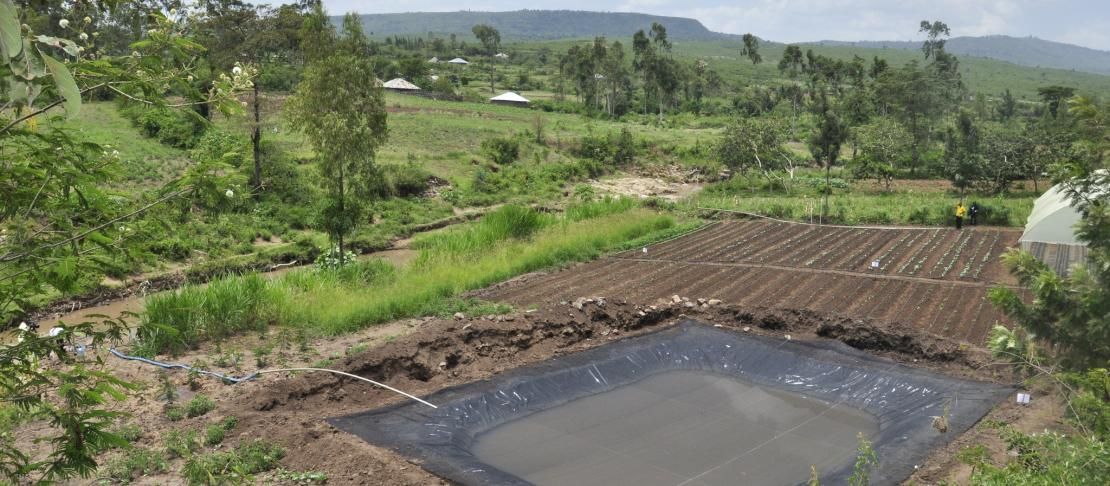Coping with unpredictable rainfall patterns in Nyando

Improved water harvesting technologies enhance crop and livestock production in Nyando Climate-Smart Villages, increasing household income and food security.
Rainfall patterns in Nyando are becoming increasingly unpredictable, manifested through late onset and early cessation of rainfall, and more frequent and long dry spells. Upon onset of rainfall, the intensity is high and leads to flooding. With changes in rainfall patterns and pressure from other climate-related risks, farmers in Nyando are forced to adjust fast. Through innovative technologies and practices supported by the CGIAR Research Program on Climate Change, Agriculture and Food Security (CCAFS) and partners, farmers are harvesting water for agricultural use. Information on the climate-smart technologies and practices is shared through increased awareness, trainings, exchange visits and local farmer learning events.
Water harvesting innovations for crop and livestock production
Collecting surface runoff—water that flows off land when it rains—is the most common water harvesting practice in Nyando. Initially, very few farmers had small livestock watering holes with a capacity of 2,000 litres for collecting surface runoff, with the majority (98%) of the households relying on rivers and streams. The improved water harvesting pans farmers are constructing vary in their capacity, ranging from 48,000 ‒100,000 litres for individual households. The water can be used for a period of up to three months. The smart farms comprised of greenhouse farming combined with drip irrigation (micro-irrigation) have water harvesting structures with a much bigger capacity of up to 300,000 litres, and are also used for fish farming. Increased micro-irrigation in dry spells is used specifically for fast maturing high value crops such as tomatoes, onions, collards and cabbages. Where water is sufficient, fruit trees such as grafted mangoes, pawpaw and passion fruits are also irrigated. The water is also used for enhancing livestock production through watering, especially the small ruminants and lactating cows and their calves.
In the year 2011, there were about 10 watering holes in the Nyando Climate-Smart Villages. The number increased to over 120 water harvesting pans by mid-2016, with an average capacity of 50,000 litres that supply water for about three months. Few farmers who can afford have purchased and installed dam liners to prevent water seepage, while others have added shade nets to control evaporation. The majority of farmers with water pans, however, cannot afford dam liners and instead resorted to compaction of the pan. With the water pans, many farmers can maintain their fruit orchards and kitchen gardens during dry spells; while the livestock no longer suffer from dehydration leading to good health and increased productivity. Overall, the productivity of the vegetables and fruits has increased, and an increase in milk production observed as a result of the water harvesting innovation.
How are farmers benefiting?
Eddy Ouko is one of the champion farmers practicing micro-irrigation in Nyando. Eddy has two water pans that he uses to irrigate his vegetable garden, orchards, and livestock. He learned about the water harvesting technology among other improved practices through farmer field schools under Kisumu County Government agricultural programs, and from research and development institutions.
Water pans have increased water availability for my crops and livestock. Although manual pumping of water using the Money Maker Pump is involving, my income doubled within the first season I used the water harvesting practice because the risk of water stress was addressed. Subsequently, I increased the number of pawpaw plants from less than 10 to 120, and grafted mangoes from 13 to 75 stems. From 2013 to 2016, my average annual gross income from farming has increased three fold.” Eddy Ouko – farmer Jimo village of Nyakach, Kisumu County.
More enterprising farmers have taken a step further and incorporated fish farming in their water pans. John Obuom, for example, earned USD 800 from catfish farming in his two pans with a combined capacity of 120,000 litres. Currently, less than 20% of the farmers have these structures, mainly attributed to the intense labour requirements for digging and compaction; as well as high cost of dam liners. However, there is huge potential for uptake of the innovation by over 50% of the households in the next five years.
Read more about how farmers in the Nyando CSVs are coping with climate change:
- CCAFS Blog: Diversifying fodder for improved livestock productivity in Nyando
- Macoloo C, Recha J, Radeny M, Kinyangi J. 2013. Empowering a local community to address climate risks and food insecurity in Lower Nyando, Kenya. Case Study prepared for Hunger • Nutrition • Climate Justice • 2013 | A New Dialogue: Putting People at the Heart of Global Development. Dublin, Ireland: Irish Aid.
- CCAFS Info Note: Kinyangi J, Recha J, Kimeli P, Atakos V. 2015. Climate - smart villages and the hope of food security in Kenya. CCAFS Info Note. Copenhagen, Denmark: CGIAR Research Program on Climate Change, Agriculture and Food Security (CCAFS).
- Grand greenhouse plans keep youths farming for a better future
John Recha is a Post-Doctoral Fellow - Participatory Action Research at CCAFS East Africa, while Wilson Okila and Wilson Nindo work at VI Agroforestry. This story was edited by Catherine Mungai and Maren Radeny (CCAFS).



